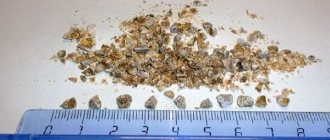Unfortunately, today sand in the kidneys is a very common problem among the population around the world. Therefore, many will be interested in how to remove sand from the kidneys. If someone is going to self-medicate using traditional medicine recipes, they should consult a specialist. Otherwise, unpleasant consequences cannot be avoided.
It is worth noting that before removing sand from the kidneys, no more than one month should pass after examination by a specialist. If you self-medicate six months after this procedure, then there is a greater likelihood that the sand in the kidneys has already turned into stones. A completely different therapy is used for stones, and in no case are diuretic herbs used for these purposes. Speaking about how to remove sand and stones from the kidneys, it is worth noting that only in rare cases is it possible to get rid of stones using folk remedies, which cannot be said about sand.
Causes of sand
Before you begin self-medication, it is worth analyzing the possible causes and provoking factors for the appearance of sand in the kidneys. First of all, this should include the patient’s lifestyle. Most people live in cities, trying to consume as little water as possible. This is due to the fact that in such conditions you want to go to the toilet as little as possible.
Another important reason for the appearance of sand in the organ is the lack of high-quality drinking water. Thus, the liquid that flows from taps is far from harmless and can cause harm to health. Therefore, many people prefer to replace drinking tap water with other drinks, such as coffee, tea, juice. This is incorrect; the human body first of all needs clean and simple water.
In addition, the kidneys must function constantly, and not from time to time. If drinking water is hard, it must be passed through a filter.
Another possible reason for the appearance of sand is considered to be impaired metabolism in the body. If these disorders are associated with any diseases, for example prostate adenoma, then there is a high probability of sand appearing. There are a number of chronic diseases that can affect the timely outflow of urine and its composition.
In addition, another possible reason for the appearance of sand is considered to be a violation of calcium metabolism. This also includes taking medications for a long time, which contain large amounts of calcium.
A sedentary lifestyle and monotonous diet can also cause this disease. If the diet contains mainly spicy and salty foods, this can lead to the formation of sand in the kidneys. In particular, this applies to foods that contain large amounts of proteins and oxalic acid. Such products must be limited to consumption by those people who suffer from urolithiasis or are prone to the appearance of sand and stones in the organ. Others should simply exercise moderation in consuming such foods. Celery, spinach, nuts, beets, green peppers, sorrel, strawberries, grapes, liver, babas can be deposited in the form of stones and sand in the kidneys. Chocolate and cookies are also no less dangerous.
Cleansing with watermelon
Watermelon is a strong diuretic, you know it yourself. If you eat watermelon, as they say, “from the heart,” then you have to run to the toilet more than once. So we will use this ability of watermelon to flush the kidneys and remove toxins from them.
How to clean
The urinary system is most active from 17 to 20 hours. During this time, eat as much watermelon as you can handle. You can’t eat anything else at this time! Now the body should be engaged in cleansing the kidneys, and not digesting food.
Then, when you’ve eaten your fill of watermelon, sit in a hot bath (the water temperature should be such that it’s pleasant to be in it). Sit there until you need to go to the toilet. Tip: place a bucket or basin next to the bathtub so you don’t have to jump out of the water and run to the toilet.
During warming, the ureters expand, thanks to which sand and small pebbles easily pass through them and are excreted from the body with urine. Do this procedure (eating watermelon and sitting in the bath) three to five times, every other day. This will be the course of watermelon kidney cleansing.
How often should you clean?
Watermelons are a seasonal product. Therefore, this cleaning is carried out at the end of summer - beginning of autumn. In the first year, it is better to do it twice, with an interval of one month. And then you can do it once a year.
Symptoms of the presence of sand
When talking about how to remove sand from the kidneys, you should first consider the symptoms of its presence in the organ. First of all, you need to pay attention to the fact that there is pain when urinating, and there is also pain directly in the groin. In parallel with this, pain may appear in the lumbar region. However, sand in the kidneys may not always cause pain. As a rule, fine sand collects in the organ painlessly. When pain appears, this indicates that the disease has begun to develop into an acute form.
In parallel with this, the temperature may rise, blood pressure may increase, and renal colic may be felt. Urine may change its color. As a rule, it becomes cloudy due to the inflammatory process or darkens due to the presence of blood. Due to poor urine flow, there is also a possibility of swelling.
Cleansing with beetroot broth
It is good because it simultaneously cleanses both the liver and kidneys. Therefore, if you have already done this procedure, then you do not need to cleanse your kidneys, at least this time.
Let me remind you that beets are an extremely healthy product! It perfectly removes harmful substances from the body, so it is widely used to improve the liver, kidneys, and cardiovascular system. And in terms of the content of microelements, it ranks one of the first places. So click on the beets and you will be healthy and beautiful!
Basic methods of sand control
Before you begin self- or medical treatment, you must:
- Do an ultrasound of the kidneys to confirm the absence of stones.
- Take a urine test so that a specialist can evaluate the acidity and levels of other chemical compounds, thereby determining the nature of the origin of the sand.
- X-ray of the kidneys, which is usually prescribed when ultrasound results are controversial.
An initial examination allows you to avoid serious consequences, which should include rupture of the urethra or ureter. The examination also helps to select the most optimal treatment option, based on the nature of the origin of the sand.
To get rid of sand, you can use several treatment methods:
- Use of medications.
- Using folk recipes.
- Following a certain diet.
- A combination of several methods at once (this is often the best option).
Watermelon
One of the simplest, most effective and enjoyable methods of cleansing the kidneys is a fasting day for the human body. It is best to arrange such fasting days on watermelons. To do this, you need to eat only watermelon with rye bread throughout the day. The more watermelon a person can eat, the better it will be for his body. In this case, sand begins to come out of the kidneys immediately. It is worth paying attention to the fact that most experts also recommend stopping eating white bread forever, since it is made on the basis of so-called dead wheat, so this product does not provide any benefit to the human body.
If the patient’s kidneys are already severely neglected, then it is necessary to adhere to the watermelon diet for a whole week. In addition, for prevention purposes, doctors recommend consuming watermelon for those people who have a tendency to form sand in the kidneys throughout the year.
There are also other foods that remove sand from the kidneys, such as cucumbers or apples.
Cleaning with rosehip infusion
Rosehip is an excellent diuretic. In addition, it contains a large amount of vitamin C. Therefore, this time we get a double effect: we not only cleanse the kidneys, but also “refuel” with vitamins! You will need dry rose hips.
How to clean
Lightly crush the fruits in a mortar or pass them through a coffee grinder, then the infusion will be as rich as possible. But if you don't have time or are lazy, you can use them all. Take 4-5 tbsp. spoons of rose hips, throw them into a thermos and pour two glasses of boiling water - this will be the dose for one day. Let it steep in a thermos overnight.
The infusion should be dark and rich, much like regular tea (although compared to tea it is not as clear). Its taste is quite pleasant, slightly sour.
If your infusion is too light, add more rose hips next time. In the morning on an empty stomach, drink one glass of infusion. Drink the second glass in the evening before bed. Do this for two weeks - this will be a course of cleansing.
How often should you clean?
For the first time, this course can be carried out three times a year, with an interval of three to four months. Then it is enough to do it once a year.
Horsetail
The most effective remedies for sand in the kidneys are various herbs. Speaking about which herb to remove sand from the kidneys, first of all it is worth mentioning horsetail. Externally, this plant looks like a small Christmas tree; horsetail grows mainly on sandy soils. People tend to equate this plant with a weed, so finding horsetail is not difficult. In addition, this herb can be purchased at the pharmacy. For a full course of treatment, as a rule, you will need no more than 3 boxes of this raw material.
To prepare an effective remedy for sand, you need to take one teaspoon of dried horsetail in crushed form, pour it into a glass or cup, pour boiling water over it, and let it brew for half an hour. The resulting solution is taken 30 minutes before eating. The advantages of this recipe are that the product is quite easy to prepare. However, a change in your morning routine will be required. After all, you will have to get out of bed 5 minutes earlier to boil water and make such an infusion. After this, you will need to wait another half hour, then the same amount of time, and then start breakfast. As for the diet, no changes are required here.
Herbal remedies for stress relief
One of the most common diseases is inflammation of the kidneys and renal pelvis (pyelonephritis), which leads to complications in the form of renal failure and high blood pressure.
Treatment is aimed at removing fluid from the body; this is facilitated by decoctions of bearberry and horsetail. And an infusion of oats helps get rid of edema, which is directly related to insufficient kidney function.
Inflammatory processes in the kidneys are closely related to inflammation of the bladder - cystitis. It develops due to hypothermia and infection in the bladder. Tea made from bearberry, yarrow and birch buds helps relieve irritation.
When these diseases worsen, herbal infusions are taken in loading doses: 5 tablespoons of herbs per liter of boiling water. This portion must be drunk during the day.
It is useful to take herbal decoctions both in autumn and spring, in the usual dose (2 tablespoons per 0.5 liter of boiling water) - to prevent exacerbations of pyelonephritis and cystitis, as well as for colds that can provoke these diseases.
For cystitis, sitz baths made from herbs help well: birch leaves, currants, eucalyptus, sage herbs, sweet clover, horsetail, chamomile and calendula flowers - you can make a mixture yourself or buy it at the pharmacy. The decoction is made at the rate of 3 tbsp. spoons of dry mixture per liter of boiling water.
Before use, be sure to strain and then add to your bath water. Take it no longer than 10–15 minutes, 1–2 times a day for a week.
Rose hip
Speaking about how to remove sand from the kidneys using folk remedies, it is also necessary to consider rosehip, which is very effective in the fight against this disease. To prepare a decoction, you need to take rosehip roots, which are at least 3 years old, and chop them. In the evening, pour 2 teaspoons of this raw material into one liter of boiling water and simmer over low heat for 10 minutes. After this, the resulting broth must be poured into a thermos so that it can brew there. The next day, the resulting remedy is drunk half a glass three times a day.
It is worth paying attention to the fact that when drinking, it is necessary to use a straw so as not to damage the enamel of the teeth. After drinking the decoction, it is also recommended to rinse your mouth with water. The course of treatment with this decoction is two weeks, after which it is necessary to take a break of 1 month. If necessary, repeat the course of treatment again.
Medicinal herbs for kidney and urinary tract diseases
- Parsley fruits, hernia herb, peppermint - 2 tbsp each. Bearberry leaves - 8 tbsp. Decoction: pour 2 cups of water, tbsp. mixture of herbs overnight. In the morning, boil for 7-10 minutes, strain. Take 1 glass of infusion on an empty stomach, and distribute the rest into 4 doses during the day, an hour after meals.
- Bearberry leaves, St. John's wort - 4 tbsp. Birch buds, horsetail - 3 tbsp. Corn silk, hernia, oregano and chamomile flowers - 2 tbsp each. Prepare and take - the same as the previous collection.
- Leaves of bearberry, hernia and knotweed - 4 tbsp each. Parsley fruits, celandine - 1 tbsp. Rose hips - 3 tbsp. Decoction: tbsp. Pour medicinal herbs into a glass of cold boiled water. Leave for 6 hours, boil for 10 minutes, leave until cool and strain. Take one third of a glass 3 times a day, 30-40 minutes after meals.
Cleansing and treating the kidneys with herbal mixtures from medicinal herbs: seeds, roots and leaves of plants, diuretics, has a positive result only with regular and cyclic use of infusions and decoctions. It will take patience and time, but you can find both for your health.
Millet
When discussing how you can remove sand yourself at home using folk remedies, it is also necessary to mention a recipe using millet. To do this, rinse the raw material well in half a glass, pour one liter of water over the millet and simmer over low heat for 4 minutes. Remove the broth from the heat and let it brew until a white foam forms. Strain the broth and drink the resulting water in several small sips throughout the day. In this case, the millet can be cooked and then simply eaten as porridge.
Diuretic fees
- Lingonberry leaves, peppermint, corn silk, nettle leaves - 5 tbsp each. Decoction: 1 tbsp. pour the mixture with a glass of water at room temperature for 6 hours. Then heat in a water bath for 15 minutes. Take 0.3 cups 3 times a day.
- Horsetail, chopped and birch leaves - 5 tbsp each. Chicory root, strawberry leaves - 2 tbsp each. Cumin or dill seeds - tsp. Take the same as the previous collection. Horsetail infusion can be drunk periodically throughout the week as a preventative, health-improving, tonic, and anti-inflammatory agent.
- Birdweed, birch leaves - equally. Add rose hips and mint or lemon balm. It is advisable to take the infusion in the afternoon or on weekends - it has an increased diuretic effect.
- Dandelion root, juniper berries, birch buds - 2 tbsp each. Tbsp. collection, pour a glass of boiling water, leave for 1 hour. Take 3 times a day, 1 tbsp.
- Bearberry leaves – 4 tbsp. Celandine, parsley and fennel seeds - 1 tbsp each. Infusion: 1 tbsp. collection, pour 2 cups of boiling water, leave, strain. Take 1 glass 2 times a day after meals.
- Lingonberry leaves, lemon balm, parsley seeds, stinging nettle leaves, horsetail - 3 tbsp each. Infusion: 1 tbsp. pour a glass of boiling water over the collection and leave for 30-40 minutes. Take 0.5 cups 30 minutes after a meal, warm.
Patients with kidney pathologies can use fresh juices from dandelion, plantain, horsetail, lungwort, nettle, chicory to restore kidney function, lower blood pressure and eliminate the inflammatory process.
What medications can be used to remove sand from the kidneys?
Currently, there are many different medications that can fight this disease. When talking about what medicine removes sand from the kidneys, you need to pay attention to the fact that these medicines are mainly made on the basis of herbal ingredients. As a rule, such medicines include extracts from rhizomes, leaves and fruits of plants, as well as their extracts.
For example, Cyston is capable of dissolving phosphate and oxalate formations in the kidneys. In addition, this drug, due to its strongly expressed diuretic effect, can affect the physical yield of absolutely any sand in composition.
When considering how to remove sand from the kidneys, it is also worth Fr. It must be said that this remedy is prescribed only by a doctor, who must accurately select the dosage and prescribe the duration of treatment for the disease. “Magurlit” promotes the rapid release of urine, as well as some shifts in acidity and small particles.
Preventive norms for the appearance of sand in the kidneys
In order to never encounter this disease and not think about how to remove sand from the kidneys, it is necessary to follow a number of preventive measures. Basically, they are based on the correction of the entire lifestyle, thereby reducing the risk of re-formation of sand in the kidneys. First of all, it is necessary to increase physical activity. At the same time, it is not necessary to choose running; you just need to take walks every day at a brisk pace, and also do morning exercises.
Natural diuretics must be present in the diet, for example, watermelon, cranberry juice, rosehip decoction. Experts also recommend not to endure the urge to urinate for a long time. The fact is that due to stagnation of urine, salts begin to accumulate in the kidneys, which over time turn into sand and even stones. It is also necessary to stop drinking alcoholic beverages, if in this case we are talking about excessive and frequent libations.
Medicines that contain large amounts of calcium should be taken only according to the recommendations of specialists, while observing the exact dosage, since excess calcium can lead to the deposition of kidney stones.
It is imperative to adhere to the drinking regime and also eat on time. You should categorically give up bad habits. If you experience symptoms that are similar to signs of sand in the kidneys, it is better to immediately contact a medical facility. There the doctor will order an examination and tell you how to remove sand from the kidneys.
In conclusion, it is worth noting that the initial stage of urolithiasis is the deposition of small salt crystals in the kidney tissues. If treatment is not started in time, this sand can turn into stones. Therefore, when the first symptoms appear, you should not ignore them, but it is better to immediately seek help from specialists who will prescribe an examination. Next, listen to the doctor’s advice on how to remove sand from the kidneys and follow it.











